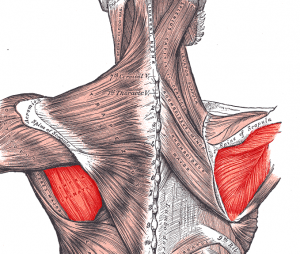In this post we take a look at the curious case of infraspinatus muscle weakness in pro tennis players.

Take 125 elite level female tennis players and assess their shoulders. In particular take a look at their dominant shoulder and a muscle that is important to the serve, the infraspinatus.
What do you think you’d find?
You’d imagine that a muscle which is involved in the tennis serve would be larger on the dominant side right?
Wrong.
Researchers at Stanford University found that in over half (52%) of the tennis players they assessed, there was evidence of an atrophied (wasted) infraspinatus.
So a muscle that you’d think is being used more, was actually showing signs of not being used much at all.
This is not the first time this effect has been seen. Previous studies have found the same thing in baseball pitchers and volleyball players.
And fascinatingly, you’re more likely to see it in professional athletes compared to their amateur counterparts.
Why would that be?
When the demands on a muscle exceed its tolerance, your central nervous system (CNS) may respond by inhibiting the muscle in order to prevent injury.
If a muscle is inhibited it can’t contract effectively. Should this situation be allowed to continue, the muscle will become weaker despite continued activity. Maybe even because of it.
So the first thing to learn from these studies is that too much of something can actually make your muscles weaker.
But wait there’s more..
To learn why the infraspinatus muscle appears to be particularly prone to overuse in overhead athletes, we have to know what it does.
Let’s take a look at it’s role during the tennis serve.

Studies that have used EMG to investigate the activity of the shoulder muscles during the tennis serve, have found that infraspinatus is most active during the deceleration phase. In other words it acts as the brakes.
Now think about this, who specifically trains the brakes?
I remember a conversation with a colleague in the US who trains pro golfers. He found the biggest gains in club head speed didn’t come by training the muscles that produced acceleration. But rather from focussing on the muscles that controlled deceleration.
To use a car analogy, the faster the car can go, the better the brakes need to be. Your CNS will only give you the power you can control. Makes sense right?
In the tennis serve that deceleration isn’t just the responsibility of the infraspinatus. It can be traced back to the muscles that attach the scapula to the spine. The muscles in the trunk that are opposite side rotators. Even to the muscles of the opposite hip and lower leg.
Summary
Whilst it’s possible to conclude that atrophied muscles in professional tennis players can’t be that important. After all these players still manage to operate at a very high level without them.
It’s also possible to look a little deeper and think that they’re actually very important. So important in fact that the atrophy is the result of overuse.
And that those muscles may not be the only ones.
Professional athletes are seriously good at compensating around weakness. That’s part of the reason why they’re professional athletes.
Locating and strengthening areas of specific muscle weakness using Muscle Activation Techniques (MAT) and resistance training gives us all the potential to be so much better however.